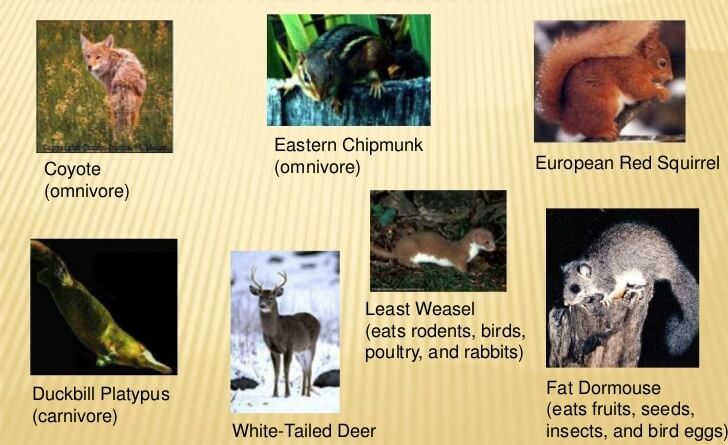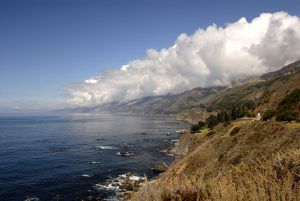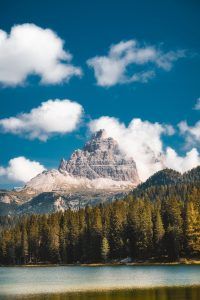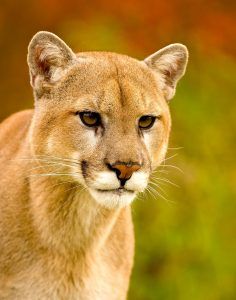Temperate Climate: [Characteristics, Flora, Fauna and Adaptability]

Important points about the temperate climate:
- What is? The temperate climate is generated with the passage of the four seasons, which are manifested with adjusted and not very intense temperature variations.
- Where it is located? The temperate climate ranges from latitudes 45° to 60°, both for the northern and southern hemispheres.
- What flora predominates? Characteristic trees of temperate climates are conifers, larch and oak, among others of great size. Prairies are another ecosystem that is often seen very frequently in the temperate climate.
- What fauna predominates? The fauna of the temperate climate is represented by deer, bears, cougars, squirrels, eagles, bats, tuna, among others.
- How long is the day and night? Summer lasts longer during the day than at night, at a ratio of 15 hours of daylight to 7 hours at night. With winter the opposite condition occurs.
- Can human beings live in this climate? Meteorologists and scientists linked to the climate issue agree that the temperate climate is the one that offers the best conditions for human life.
 The temperate climate is a manifestation that is characterized by a small range of thermal variability with respect to winter and summer.
The temperate climate is a manifestation that is characterized by a small range of thermal variability with respect to winter and summer.
It is a mild climate, which tends to occupy more than 10° C in most of the year without exceeding 30° C, so it becomes quite pleasant.
It has variations that are influenced by the conditions of the environment where it is, including winds, precipitation and relief. Is there a temperate climate in the area where you live or do you want to discover a little more about it? Here we will tell you everything.
What is temperate climate?
 The temperate climate is generated with the passage of the four seasons, which manifest themselves with adjusted and not very intense temperature variations.
The temperate climate is generated with the passage of the four seasons, which manifest themselves with adjusted and not very intense temperature variations.
This means that the summers are not very hot and the winters are not particularly cold.
It has very pleasant conditions for life in general, which is why there are numerous species of flora and fauna, as well as a high population density.
It is a climate that, due to its characteristics, is divided into other types that adjust their conditions depending on factors such as proximity to the ocean.
Where is the temperate climate located geographically?
 The temperate climate ranges from latitudes 45° to 60°, both for the northern and southern hemispheres.
The temperate climate ranges from latitudes 45° to 60°, both for the northern and southern hemispheres.
This occupies from the tropics of Cancer and Capricorn to the north and south polar circles, respectively.
It can be seen in areas such as England, France, Italy, Brazil, South Korea, a part of the United States, Spain, South Africa, Chile and Argentina, just to mention a few countries.
What characteristics does a temperate climate have?
The temperate climate meets a series of characteristics that must be met in order to be classified as such:
- Temperatures: they have a narrow margin of action, being the minimum in winter -3° C and maximum 20º C in summer. The general average is located at 15º C, most of the day. Its location is between the subpolar climate and the subtropical climate, so mesothermal and microthermal variations can be found.
- Precipitation: occurs relatively frequently, being possible to reach up to 2000 mm per year. Precipitation is usually distributed throughout the year, becoming more frequent during the winter and more than anything in those areas that are closer to the coast.
- Winds: they are frequently present and are influenced by the presence of the dominant air masses coming from the polar zone and the tropical zone, as well as the atmospheric pressure of each moment.
- Types: the members of the temperate climate family are very numerous, but we can mention the 4 most characteristic ones, which are the Mediterranean climate, the continental climate, the oceanic climate and the humid climate.
What flora predominates in the temperate climate?
 Climatic conditions of this type are ideal for the development of plant life, which is why it is common for there to be so many forests and arable land within its limits.
Climatic conditions of this type are ideal for the development of plant life, which is why it is common for there to be so many forests and arable land within its limits.
In forests, trees can be evergreen or deciduous depending on the temperature reached during the winter.
Characteristic trees of temperate climates are conifers, larch and oak, among others of great size. Prairies are another ecosystem that is often seen very frequently in the temperate climate.
Thanks to the constant presence of rains, a profitable growth of grasses is possible.In the case of crops, it is possible to exploit many varieties, including from fruit trees to crops of low height but large extension such as corn and wheat.
What fauna predominates in the temperate climate?
 The fauna is also very diverse and ranges from microorganisms to large species.
The fauna is also very diverse and ranges from microorganisms to large species.
The forests are the main center of animal life in the temperate climate and, in them, each one establishes its development schedule throughout the year.
Some have managed to adapt to changes and tolerate both winter and summer well, especially when they are not very strong.
Others, on the other hand, have established a protection system against low temperatures, either by undergoing the hibernation process or by migrating. The fauna of the temperate climate is represented by deer, bears, cougars, squirrels, eagles, bats, tuna, among others.
It also features a large number of colorful birds that manifest themselves in butterflies of all types and colors, for example.
How long is the day and night in the temperate climate?
 The length of day and night is influenced by the planet’s motion around the sun, which defines its degree of tilt.
The length of day and night is influenced by the planet’s motion around the sun, which defines its degree of tilt.
This supposes a difference in the form in which the solar rays are projected on the terrestrial surface and, therefore, defines the duration of the day and the night.
This inclination manifests itself with the summer and winter solstices, allowing summer to last longer during the day than at night, at a ratio of 15 hours of light for 7 hours at night.
For its part, with winter the opposite condition occurs, since its nights are longer than its days, taking up to 15 hours of night for 7 hours of day.
Can humans live in the temperate climate?
 Meteorologists and scientists linked to the climate issue agree that the temperate climate is the one that offers the best conditions for human life.
Meteorologists and scientists linked to the climate issue agree that the temperate climate is the one that offers the best conditions for human life.
Thanks to its characteristics, it is possible to establish communities that can sustain themselves with the work of the land, animal husbandry and industrialization.
In addition, it does not require major logistical elements to live during the summer and winter, beyond air conditioning and heating. The temperate climate is a pleasant climate, with few changes throughout the year, which allows you to exploit the land and enjoy raising farm animals.
Thanks to the fact that it has a humid environment due to rainfall, it is possible to enjoy a great variety of vegetation and fauna. And, with all its types, it is more than feasible to ensure that the temperate climate is very beneficial in all aspects.
Bibliographic references
- Effect of climate variability on the state of vegetation and water cover in a temperate climate basin (Argentina), A Brendel, VY Bohn, MC Piccolo – 2017 – ri.conicet.gov.ar
- Temperate climate fruit trees, E Cásseres – 1966 – books.google.com
- Fruticulture-Fruit maturity: Fruits of temperate and subtropical climates, G Gil – 2012 – books.google.com
- Proposal to determine forest fire danger indices in temperate climate forests in Mexico, GER Martínez, JS Pérez, HR Maldonado… – … Forest Sciences and …, 2001 – redalyc.org
- spring frosts. protection in temperate- cold climate fruit trees, MA Tassara – 2007 – sidalc.net
Maybe you are also interested in:
- Koppen climate classification: [Concept, Characteristics and Types of Climates]
- Alpine Climate: [Characteristics, Flora, Fauna and Adaptability]
- Arid Climate: [Characteristics, Flora, Fauna and Adaptability]
- Temperate Continental Climate: [Characteristics, Flora, Fauna and Adaptability]
- Continental Climate: [Characteristics, Flora, Fauna and Adaptability]
- High Mountain Climate: [Characteristics, Flora, Fauna and Adaptability]
- Climate of Argentina: [Characteristics, Flora, Fauna and Adaptability]
- Australia Climate: [Characteristics, Flora, Fauna and Adaptability]
- California Climate: [Characteristics, Flora, Fauna and Adaptability]
- Climate of Europe: [Characteristics, Flora, Fauna and Adaptability]
- Tundra Climate: [Characteristics, Flora, Fauna and Adaptability]
- Equatorial Climate: [Characteristics, Flora, Fauna and Adaptability]
- Cold Climate: [Characteristics, Flora, Fauna and Adaptability]
- Cold Weather: [Characteristics, Flora, Fauna and Adaptability]
- Mediterranean Climate: [Characteristics, Flora, Fauna and Adaptability]
- Ocean Climate: [Characteristics, Flora, Fauna and Adaptability]
- Polar Climate: [Characteristics, Flora, Fauna and Adaptability]
- Subpolar Climate: [Characteristics, Flora, Fauna and Adaptability]
- Subtropical Climate: [Characteristics, Flora, Fauna and Adaptability]
- Subhumid Temperate Climate: [Characteristics, Flora, Fauna and Adaptability]
- Humid Tropical Climate: [Characteristics, Flora, Fauna and Adaptability]
- Dry Tropical Climate: [Characteristics, Flora, Fauna and Adaptability]



![Photo of Plant a Laurel: [Dates, Soil, Irrigation, Pests and Diseases]](https://www.complete-gardening.com/wp-content/uploads/2022/08/plant-a-laurel-dates-soil-irrigation-pests-and-diseases-390x220.jpg)
